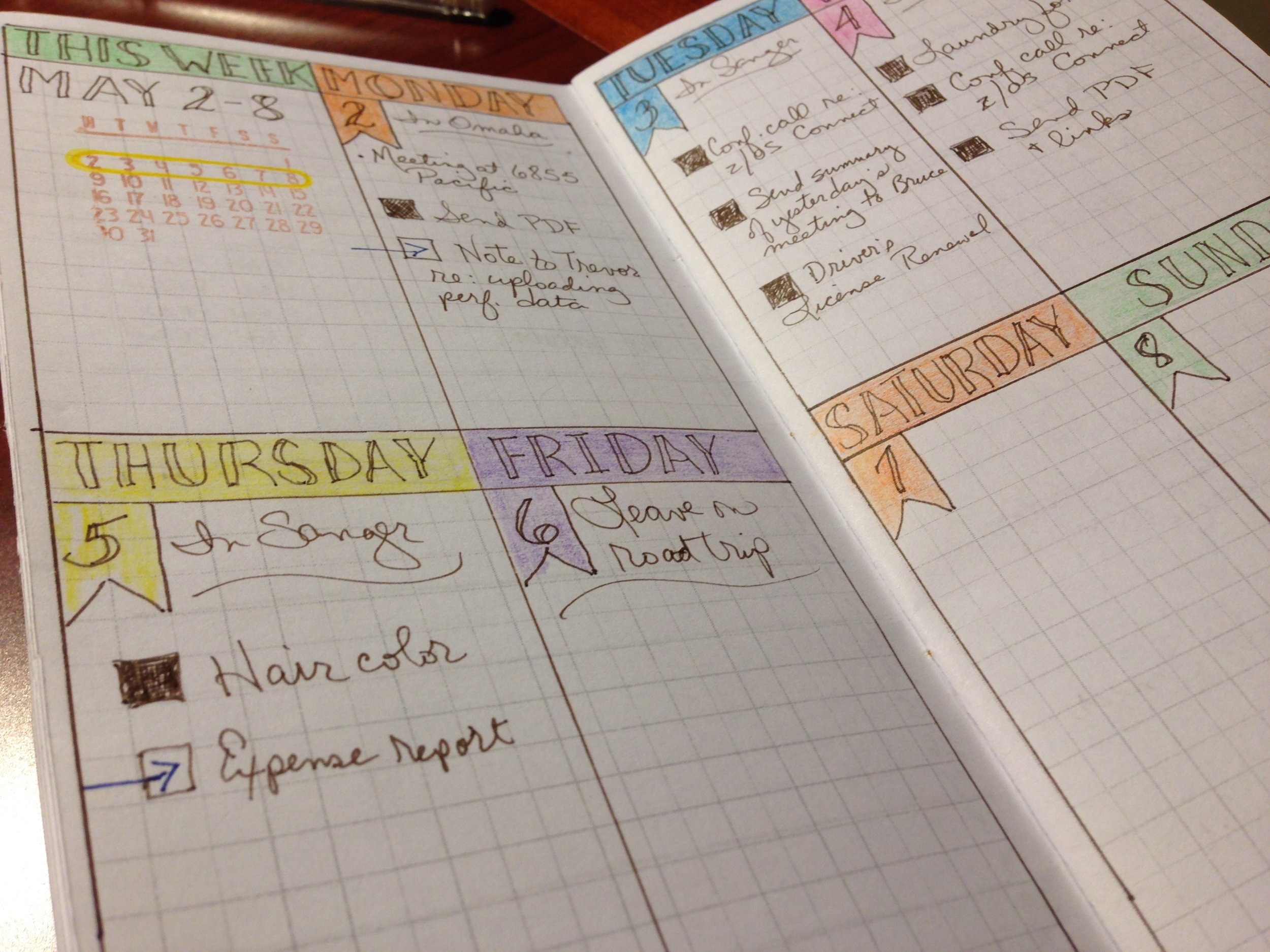The Era of the Bullet Journal

I am an obsessive list-maker. I love to plan. I love to organise. Sometimes, if I’ve forgotten to write down a task I’ve already completed, I write it in anyway just for the satisfaction of putting a tick in a checkbox (I can’t be the only one). The highlight of the new year was never the festivities, or the resolutions, it was buying a brand new planner.
I have been through my fair share of planning methods. I’ve tried having a notebook planner, I’ve tried writing checklists on my phone and setting reminders for them, I’ve made a google calendar and I’ve tried putting post-its up on the mirror. But nothing ever really stuck. There were just too many things to keep track of, my phone calendar, my physical calendar, my sheets of shopping lists and sticky notes…
Enter: The bullet journal. You may have already heard of this term floating about on the internet. It’s a notebook for everything. Your lists, your appointments, your doodles and your notes… all in one place. It is a system created by Ryder Carroll, and he describes it as a way “to help you track the past, organize the present, and plan for the future.” One of the best ways to understand the bullet journal is to watch this video (link: https://www.youtube.com/watch?v=fm15cmYU0IM). In short, it is a clean, minimalistic method to help you organise your entire life.
Google ‘bullet journal’, and you may get a completely different idea. Most bloggers have bullet journals filled with stickers, washi tape, beautiful sketches and artistic spreads. Not so barebones as the video may have lead you to believe. But this is the beauty of the bullet journal. If you want a practical, simple system, the Bujo can be just that. If you are into decorating and stationary and drawing mandalas, the Bujo is for you. It’s an adaptable system that can work for pretty much anyone. It can help you set goals, track habits, keep up with appointments and tasks… the list goes on (pun intended).
Hooked already? Here is how to get started with your very own bullet journal:
MATERIALS
You will need a couple of basic things as a bullet journal-er.
- A notebook. In theory, any notebook will do. An old unused exercise book, a sketchbook, a brand new moleskine… However, if you plan on keeping up with this system long-term or tend to make many lists, I do advise you to go for a notebook that is a bit thicker and sturdier, as you will be using it pretty much everyday! My weapon of choice is the leuchtturm 1917, but other popular choices include the moleskine, Rhodia webnotebooks and Field Notes. It can be blank, have lines, a grid or be dotted. It all depends on your preference. Lines work well if you want it to be simple but go for a dot or a grid if you like drawing up lots of trackers and other detailed spreads.
- A pen. Again, anything goes. But make sure there isn’t too much bleed through on your notebook.
That’s it. Of course, you could embellish your BuJo supplies with coloured pencils, stickers, paper tape and fancy highlighters, if you’re a stationary-junkie like me.
YOUR LAYOUT
The best way to get an idea of what you need to do is to watch the video, but here is it written out in case you couldn’t quite keep up!
- INDEX: On the first few pages, title them with the word ‘INDEX’. You may not need to do this if your notebook already has one (e.g. the leuchtturm 1917). Number all your pages if they aren’t already. This is where you will write the title of your page or collection along with the page number, so you can find relevant pages easily in the future. You can also group pages together if they have similar content. You do not have to put every page you make into the index, but do include the important ones.
- FUTURE LOG: Here is where you put everything you have planned for the year ahead, goals or notes about that month. Use symbols to help you. A dot • means a task, a circle ○ an event and a dash – for notes. Use > for events or tasks that have been rescheduled, and a× to mark those that have been completed. You can add to these symbols according to your needs! It is useful to use a page or the inside of the front cover to write all of these symbols down in a key.
- MONTHLY LOG: At the start of each month, begin a monthly log page. The simplest way to do this is by writing dates on the left hand side of the page and then whatever special event beside it. Refer to your future log to see what appointments you have planned for this month. On the adjacent page write down important tasks you have that month (using the symbols) and cross them out when you have done them. You can also add in tasks which you haven’t done the month before, just mark it with a >.
- DAILY LOG: At the start of each day, write the day and date and any tasks you have then. When the next day comes along, just add it on to wherever you stopped the day before. Check for any special events of tasks due that day on your monthly log spread and write it down. Migrate any tasks you haven’t done the day before. This will help you to stay on top of anything you have to do!
- COLLECTIONS – additional pages: The perk of having a bullet journal is the fact that it is more than just a planner. If you have, for example, a shopping list, simply start a new page and list everything you need to buy. Write ‘shopping list’ down in your index with the page number and then just cross out items on it as you put things in your basket! Other page ideas that are very popular in the bullet journaling community are monthly habit trackers, daily gratitude pages, doodle pages, handwriting practise pages, weight loss goals, notes from a seminar or book, motivational quotes… go crazy!!
The Bullet Journal is a useful tool for anyone who feels a bit overwhelmed by life at times. We all have a gazillion deadlines and events to keep track of, numerous errands to run and assignments to get done. Just putting a pen to paper to list it all down does a world of help and makes it all a bit easier to deal with. I’ve used my own bullet journal to help me in my first year of uni and now I am never, ever, going back to any other system again.
Sasha is a med student by day, crazy cat lady at night, and passionate vegan 24/7. She made the decision to go plant based for both health and ethical reasons, and has never looked back since. The madness behind the instagram @thesashadiaries, she is determined to convince everyone that being a plant-based vegan is definitely not boring!


